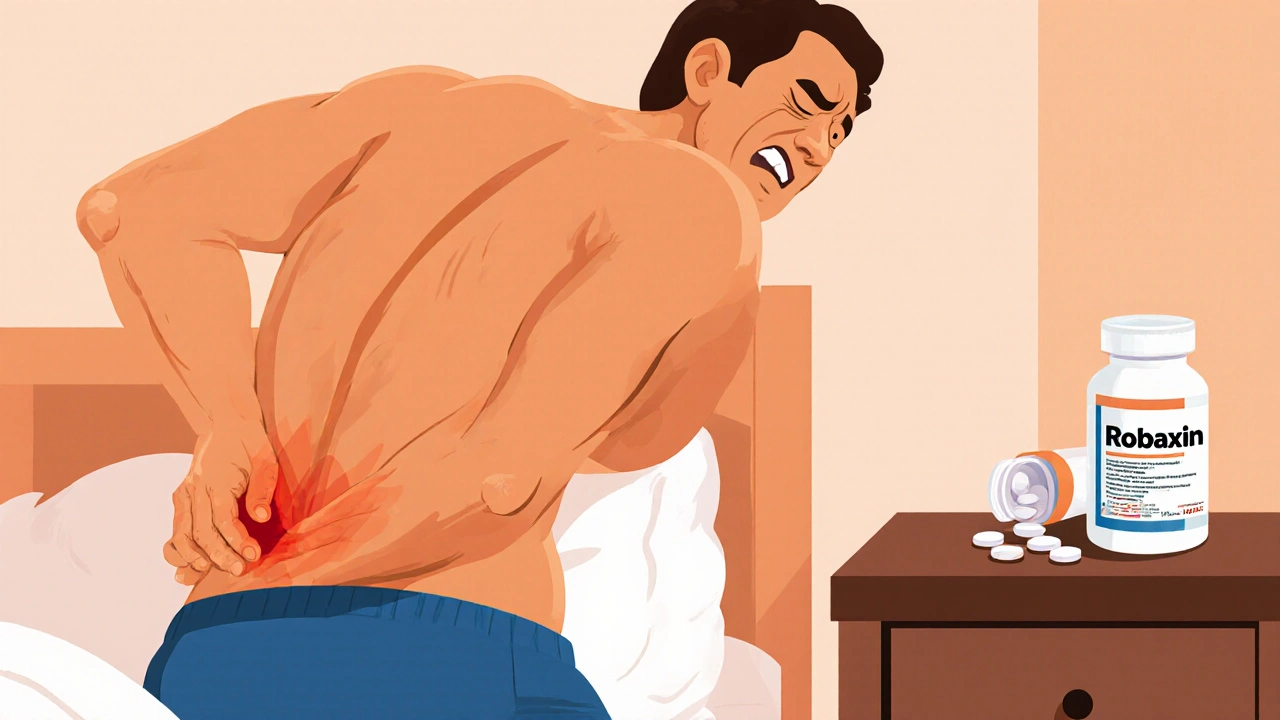
When a painful muscle spasm hits, you want relief fast and without a laundry list of side effects. Robaxin is one of the most often‑prescribed options, but it’s not the only game in town. This guide breaks down what Robaxin (methocarbamol) actually does, weighs it against the most common alternatives, and helps you decide which pill fits your situation best.
What Is Robaxin (Methocarbamol)?
Robaxin is a brand name for methocarbamol, a centrally‑acting muscle relaxant approved by the FDA for the relief of skeletal muscle spasm associated with acute musculoskeletal conditions. It works by depressing the central nervous system, which reduces the hyper‑excitable nerve activity that fuels muscle tension. The medication usually comes in 500 mg tablets, taken 3‑4 times daily, and can be combined with rest, physical therapy, or heat applications for optimal effect.
Typical uses include:
- Back strain
- Neck pain from a sudden pull
- Post‑operative muscle soreness
Common side effects are drowsiness, dizziness, and occasional gastrointestinal upset. Because it does not directly relax muscle fibers, it is considered less likely to cause the severe weakness seen with some other relaxants.
Who Typically Takes Robaxin?
Robaxin is often chosen for:
- Adults needing short‑term relief (usually 1‑2 weeks)
- Patients who cannot tolerate stronger agents like cyclobenzaprine
- Individuals with a history of liver disease (methocarbamol has a relatively mild hepatic profile)
Doctors tend to avoid prescribing it for chronic conditions because its benefit plateaus after the acute phase.
Top Alternatives to Consider
Below are the five most widely used muscle‑relaxant alternatives, each with its own strengths and drawbacks.
Cyclobenzaprine is a tricyclic‑derived muscle relaxant that works on the brain stem to reduce muscle tone. It’s often the first‑line prescription for acute muscle spasms.
Baclofen acts on spinal cord GABA‑B receptors, providing a more direct spinal muscle relaxation. It’s frequently used for multiple sclerosis‑related spasticity.
Tizanidine is an alpha‑2 adrenergic agonist that decreases nerve signals to muscles, making it popular for chronic back pain and spasticity.
Carisoprodol is a centrally‑acting relaxant that is metabolized into meprobamate, a sedative. It’s known for its quick onset but higher abuse potential.
Metaxalone is a non‑sedating muscle relaxant that works by altering neuronal activity in the spinal cord. It’s often preferred for patients who need to stay alert.
Comparison Table: Efficacy, Onset, Duration, and Side‑Effect Profile
| Medication | Typical Onset | Duration of Action | Common Side Effects | Abuse Potential | Best Use Case |
|---|---|---|---|---|---|
| Robaxin (Methocarbamol) | 30‑60 min | 4‑6 hrs | Drowsiness, dizziness | Low | Acute spasms, patients sensitive to sedation |
| Cyclobenzaprine | 30‑90 min | 8‑12 hrs | Dry mouth, constipation, sedation | Low‑moderate | Short‑term acute pain, when stronger relaxation needed |
| Baclofen | 1‑2 hrs | 2‑4 hrs | Weakness, fatigue, dizziness | Low | Spasticity from MS or spinal cord injury |
| Tizanidine | 30‑60 min | 3‑6 hrs | Dry mouth, hypotension, sedation | Low | Chronic back pain, evening dosing |
| Carisoprodol | 15‑30 min | 4‑6 hrs | Marked drowsiness, dependence | High | Short‑term severe spasm, when rapid relief outweighs risk |
| Metaxalone | 30‑45 min | 4‑6 hrs | GI upset, mild drowsiness | Low | Patients who need alertness (e.g., drivers) |
How to Choose the Right Muscle Relaxant
Picking a pill isn’t just about “which works fastest.” Consider these decision factors:
- Duration of pain: For a 3‑day strain, a short‑acting drug like Robaxin or Carisoprodol may suffice. For a multi‑week flare‑up, longer‑acting cyclobenzaprine or tizanidine can reduce dosing frequency.
- Risk of sedation: If you need to drive or operate machinery, Metaxalone or low‑dose baclofen are safer choices. Robaxin sits in the middle - mild sedation but generally tolerable.
- Medical history: Liver disease tips the scale toward baclofen (renally cleared) or Metaxalone (minimal hepatic metabolism). Kidney impairment pushes you toward drugs cleared hepatically, like Robaxin.
- Drug‑interaction profile: Cyclobenzaprine is a strong CYP2D6 inhibitor; avoid with SSRIs or beta‑blockers. Tizanidine can dangerously lower blood pressure when combined with antihypertensives.
- Abuse potential: Carisoprodol carries a Schedule IV warning in the U.S. If you have a history of substance misuse, stick to low‑abuse agents such as Robaxin or Metaxalone.
Consulting your prescriber about these variables can prevent unwanted side effects and improve recovery speed.
Cost and Accessibility in 2025
Pricing in 2025 has shifted with generic availability:
- Robaxin (generic methocarbamol): $0.15 per 500 mg tablet in the U.S., $0.10 in Canada, and about NZ$0.12 in New Zealand.
- Cyclobenzaprine generic: $0.20 per 10 mg tablet.
- Baclofen generic: $0.12 per 10 mg tablet.
- Tizanidine generic: $0.18 per 4 mg tablet.
- Carisoprodol: $0.30 per 250 mg tablet (limited generic supply).
- Metaxalone generic: $0.14 per 800 mg tablet.
Insurance coverage generally favors the cheapest generics. If cost is a primary concern, Robaxin or baclofen often win.
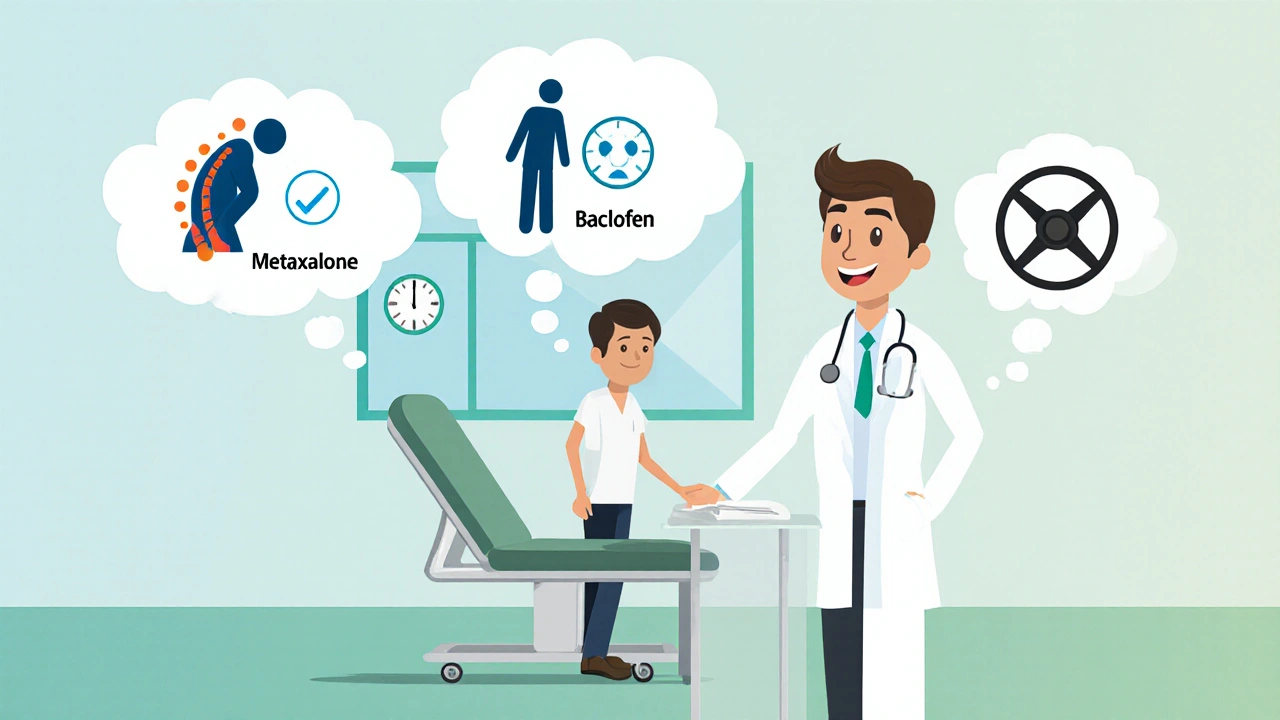
Potential Interactions and Contra‑indications
All muscle relaxants share a few red‑flags:
- Concurrent use with CNS depressants (e.g., opioids, benzodiazepines) can amplify drowsiness and respiratory depression.
- Alcohol amplifies sedation for every agent listed.
- Pregnancy: methocarbamol is Category C; cyclobenzaprine is Category B; baclofen, tizanidine, and carisoprodol are Category C. Always discuss with an OB‑GYN before starting.
- Kidney disease: avoid baclofen unless dose‑adjusted.
- Liver disease: limit methocarbamol and cyclobenzaprine; prefer baclofen or metaxalone.
Putting It All Together: Practical Recommendations
Below is a quick‑reference chart that matches patient scenarios with the most suitable muscle relaxant.
| Scenario | Preferred Choice | Why |
|---|---|---|
| Short‑term back strain, wants to stay alert | Metaxalone | Low sedation, decent pain relief |
| Acute neck spasm, tolerates mild drowsiness | Robaxin (Methocarbamol) | Balanced onset, inexpensive, low abuse risk |
| Severe spasm needing rapid relief | Carisoprodol (short‑term only) | Fastest onset, but monitor for dependence |
| Spasticity from multiple sclerosis | Baclofen | Targeted spinal action, good for chronic use |
| Evening dosing for chronic lumbar pain | Tizanidine | Works well overnight, less daytime sedation |
| Patient on multiple antidepressants (CYP2D6 inhibitors) | Avoid cyclobenzaprine; choose Robaxin or baclofen | Minimizes drug‑drug interaction risk |
Frequently Asked Questions
Can I take Robaxin with ibuprofen?
Yes, ibuprofen (an NSAID) is often combined with methocarbamol to tackle both inflammation and muscle spasm. Just watch for stomach irritation if you’re prone to ulcers.
How long does it take for Robaxin to start working?
Most patients feel relief within 30‑60 minutes after the first dose, though the peak effect arrives around the 2‑hour mark.
Is methocarbamol habit‑forming?
It has a low abuse potential compared with carisoprodol or opioids. Dependence is rare, but you should still follow the prescribed duration.
Can I use Robaxin if I have liver disease?
Methocarbamol is metabolized by the liver, so doctors usually start with a lower dose or pick a drug cleared by the kidneys, like baclofen, for severe hepatic impairment.
What’s the biggest drawback of cyclobenzaprine?
Its anticholinergic side effects-dry mouth, constipation, and potential heart‑rate changes-can be problematic, especially in older adults.
Whether you grab a bottle of Robaxin or explore another option, remember that muscle relaxants work best when paired with rest, gentle stretching, and a solid rehab plan. Always loop in your healthcare provider before swapping meds, especially if you take other prescriptions.
14 Comments
Eli Soler Caralt
October 24, 2025 AT 01:25 AM
ah, the dance of muscle relaxants is like a modernist poem, each line a different shade of drowsy bliss 😂. methocarbamol whispers rather than shouts, so you feel the relief without the night‑time coma vibe. i guess some folks just love the quick‑hit drama of carisoprodol, but it’s a risky flirt 🚀. nevertheless, if you’re chillin' and need mild sedation, Robaxin is the zen master of the bunch.
Eryn Wells
October 26, 2025 AT 12:29 PM
Hey all! 🌍 Just wanted to point out that accessibility matters as much as efficacy. In many nations, generic methocarbamol is a fraction of the price of newer agents, which can be a game‑changer for folks without comprehensive insurance. Also, remember to pair any muscle relaxant with gentle stretching and proper ergonomics – the meds are only part of the recovery puzzle.
Kathrynne Krause
October 28, 2025 AT 23:34 PM
Alright, muscle‑relax showdown! 🎉 If you’re looking to stay sharp for that afternoon shift, Metaxalone is the MVP – minimal drowsiness, decent pain knock‑down. Need something that hits fast for a nasty spasm? Carisoprodol waltzes in under 20 minutes, but keep an eye on the mellow‑down factor. And for the chronic back‑pain warriors, Tizanidine’s evening dosing can let you snooze without the morning fog.
Chirag Muthoo
October 31, 2025 AT 10:39 AM
From a clinical standpoint, the decision matrix for muscle relaxants must incorporate hepatic and renal clearance pathways. Methocarbamol undergoes hepatic metabolism, thereby necessitating dose adjustments in severe liver disease. Conversely, baclofen is eliminated renally, rendering it preferable when hepatic function is compromised. Moreover, the interaction profile of cyclobenzaprine with CYP2D6 substrates can precipitate adverse effects, a consideration for polypharmacy patients. Ultimately, individualized assessment remains paramount to mitigate iatrogenic complications.
Angela Koulouris
November 2, 2025 AT 21:43 PM
Building on that, incorporating physical therapy early can reduce the total exposure to any muscle relaxant. Even a brief, supervised stretching routine often halves the required dosage, preserving function while limiting sedation. It also empowers patients with self‑management tools, decreasing reliance on pharmacotherapy alone.
Harry Bhullar
November 5, 2025 AT 08:48 AM
Let me take a deep dive into the comparative landscape of muscle relaxants, because the nuances matter for both clinicians and patients. First, methocarbamol’s mechanism involves central nervous system depression without directly targeting the muscle fiber, which translates to a modest side‑effect profile focused mainly on drowsiness and mild dizziness. This makes it suitable for patients who cannot tolerate the pronounced anticholinergic burden of cyclobenzaprine, such as dry mouth, constipation, and potential cardiac arrhythmias. In contrast, cyclobenzaprine, a tricyclic derivative, has a longer half‑life, offering 8‑12 hours of relief, but its potency comes at the cost of greater sedation and drug‑drug interaction risk, particularly with SSRIs and beta‑blockers due to CYP2D6 inhibition.
Moving on, baclofen’s GABA‑B agonism affords a more spinally focused relaxation, which is invaluable for spasticity secondary to multiple sclerosis or spinal cord injury. However, its renal clearance mandates caution in patients with impaired kidney function, and abrupt discontinuation can precipitate severe withdrawal symptoms. Tizanidine, an alpha‑2 adrenergic agonist, presents a rapid onset and moderate duration, but clinicians must vigilantly monitor blood pressure because hypotension can be a limiting factor, especially in the elderly.
Carisoprodol, metabolized into meprobamate, provides the quickest onset (15‑30 minutes) but carries a high abuse potential. Its sedative properties can be advantageous for short‑term, severe spasms, yet the risk of dependence and regulatory restrictions (Schedule IV) often outweigh its benefits for routine use. Metaxalone, meanwhile, stands out for its non‑sedating nature, making it a go‑to option for patients who need to maintain cognitive alertness, such as commercial drivers. Its efficacy is modest compared with other agents, but the trade‑off is a lower risk of central nervous system depression.
From a pharmacoeconomic perspective, methocarbamol remains one of the most cost‑effective choices, with generic pricing hovering around $0.15 per tablet in the United States. This affordability, combined with a favorable safety profile, positions it as a first‑line recommendation for acute, short‑duration muscle spasms. Nonetheless, patient‑specific factors-such as comorbid liver disease, renal insufficiency, concurrent CNS depressants, and occupational demands-must guide the final selection.
In summary, there is no one‑size‑fits‑all muscle relaxant. The art lies in balancing efficacy, side‑effect burden, abuse potential, pharmacokinetics, and cost, all while aligning with the individual’s clinical scenario and lifestyle needs.
Giusto Madison
November 7, 2025 AT 19:53 PM
Nice breakdown, but let’s not forget the real-world pitfall: patients often stack these relaxants with opioids and benzodiazepines, blowing the sedation ceiling. That cocktail can be lethal, especially in the first 24‑48 hours when the drugs peak together. Education at discharge is critical to prevent catastrophic outcomes.
erica fenty
November 10, 2025 AT 06:57 AM
From a pharmacokinetic standpoint, the half‑life variability across agents is a key determinant for dosing intervals; longer half‑lives reduce dosing frequency but increase accumulation risk.
Xavier Lusky
November 12, 2025 AT 18:02 PM
Big Pharma pushes Robaxin to keep us dependent.
Ashok Kumar
November 15, 2025 AT 05:06 AM
Honestly, if you’re already juggling a cocktail of meds, adding another muscle relaxant is a gamble. It’s better to focus on physiotherapy and proper ergonomics than rely on a pill that makes you feel like a zombie.
Jasmina Redzepovic
November 17, 2025 AT 16:11 PM
Robaxin is just cheap sedation.
Esther Olabisi
November 20, 2025 AT 03:16 AM
Wow, such a bold claim! 😏 While I respect the passion, the evidence shows methocarbamol’s side‑effect profile is actually pretty mild. Maybe we should stick to facts and let patients decide with their doc’s guidance. 🤗
Ivan Laney
November 22, 2025 AT 14:20 PM
Let’s set the record straight: when choosing a muscle relaxant, one must consider not only the pharmacological attributes but also the socioeconomic context of the patient. The cheapest generic options, like methocarbamol and baclofen, often provide sufficient relief without the prohibitive cost associated with newer agents. Moreover, the healthcare system’s insurance formularies heavily favor those low‑cost generics, making them more accessible to the average American. Yet, beyond price, we must address the cultural stigma attached to taking “relaxant” medications, especially among older workers who fear being labeled as weak. Education campaigns can dispel myths and empower individuals to seek appropriate treatment without embarrassment. In practice, a step‑wise approach-starting with a low‑dose, low‑cost agent and escalating only if necessary-optimizes both clinical outcomes and budgetary constraints. This strategy also mitigates the risk of dependence and adverse effects, preserving patient safety while respecting their financial realities.


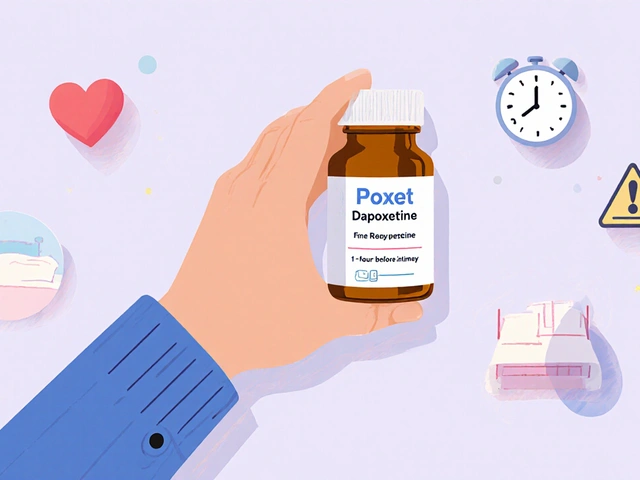
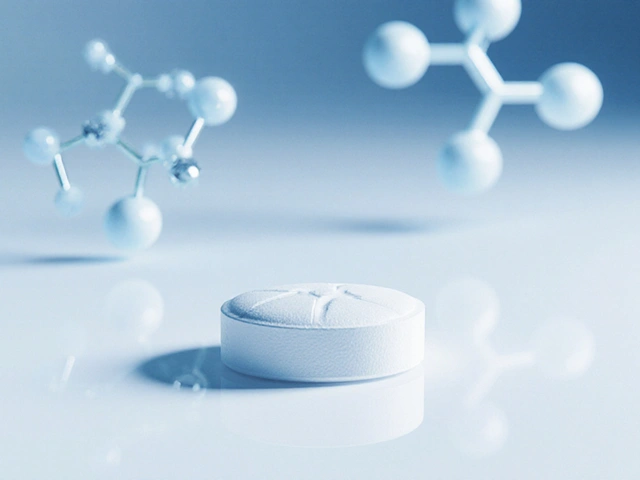

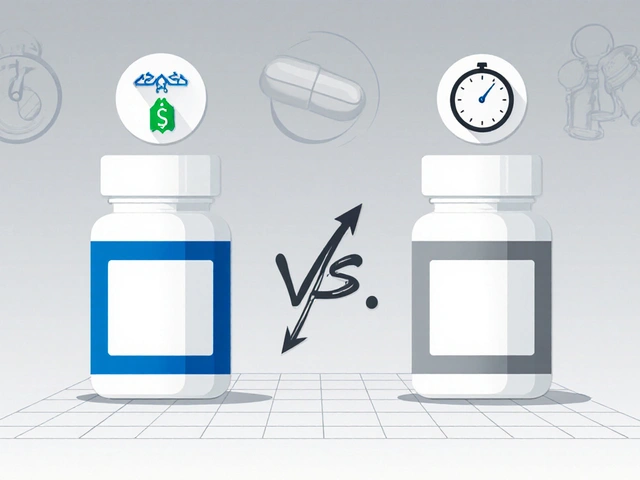
Brandy Eichberger
October 21, 2025 AT 14:20 PM
While the guide is exhaustive, one cannot overlook the nuanced pharmacodynamics of methocarbamol. Its central action is subtle yet effective, making it a respectable choice for acute spasms. Compared with the tricyclic cousin cyclobenzaprine, it spares patients from excessive anticholinergic fallout. For those who value a balance between efficacy and tolerability, Robaxin often emerges as the understated champion.